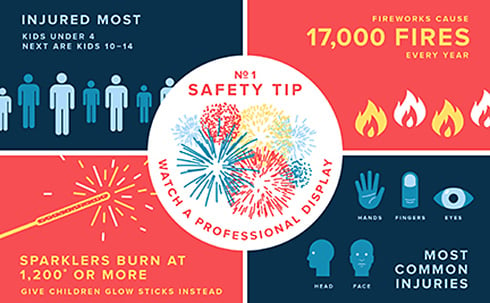Although July 4th, or Independence Day, has come and gone, there is a good possibility that some of us have a few extra sparklers, or an “All the fireworks are gone, kids – time for bed!” stash of leftovers hidden behind the stale pretzels in the top cupboard. July is Fireworks Eye Safety Month, and because fireworks sometimes become a part of many year-round celebrations, it is an excellent opportunity to clarify our understanding of the do’s and don’ts of pyrotechnic use.
While the thrill many of us derive from the thunderous booms and brilliant blooms of fireworks is undeniable, so are the sobering statistics that accompany these displays.
In recent years, in June and July alone, over 6000 fireworks related injuries occur and over 20% of those are eye injuries. These injuries can range from temporary or more superficial issues to severe, life altering injuries including burns and bleeding in the eye, retinal detachments, and even a ruptured globe or blindness. Many of these injuries occur to those who are not even handling the fireworks and, even more distressing is that frequently these injuries afflict children.

Prevent Blindness America and the American Academy of Blindness sponsor July as Fireworks Eye Safety Month to raise awareness of the dangers, as well as, the safe protocols for viewing or handling pyrotechnic displays or devices. It is critical at the outset to understand that these devastating injuries are not restricted to large explosives but are often derived from the seemingly innocent firework items we acquire from the pop-up vendors near the corner store. It is easy for any of us to get caught up in all the excitement and activity or become distracted by hosting responsibilities, conversations and crowds. Take into consideration, as well, that these festivities and shows are generally conducted past dusk and simply navigating an event with numerous people and smoke bombs can become challenging, let alone successfully dodging the searing signatures of sparkler-wielding children.
While consumer fireworks are illegal in some places in the US, most states permit the sale and use of what are considered Safe and Sane items. Whether one supports the use or ban of consumer fireworks, it is important to practice and share firework safety guidelines at private or public events.
The American Academy of Ophthalmology recommends critical practices and procedures for firework use.
Fireworks safety tips
The Academy advises that the best way to avoid a potentially blinding fireworks injury is by attending a professional public firework show rather than purchasing fireworks for home use.
For those who attend professional fireworks displays and/or live in communities surrounding the shows:
- Respect safety barriers at fireworks shows and view fireworks from at least 500 feet away.
- Do not touch unexploded fireworks; instead, immediately contact local fire or police departments to help.
For those who decide to purchase consumer fireworks because they live in states where they are legal, the Academy recommends the following safety tips to prevent eye injuries:
- Never let young children play with fireworks of any type, even sparklers.
- People who handle fireworks should always wear protective eyewear that meets the parameters set by the American National Standards Institute and ensure that all bystanders are also wearing eye protection.
- Leave the lighting of professional-grade fireworks to trained pyrotechnicians.
What to do in the event of a fireworks eye injury
If an eye injury from fireworks occurs, remember:
- Seek medical attention immediately.
- Do not rub your eyes.
- Do not rinse your eyes.
- Do not apply pressure.
- Do not remove any objects that are stuck in the eye.
- Do not apply ointments or take any blood-thinning pain medications such as aspirin or ibuprofen.
https://www.friendsforsight.org/resources/eye-health-awareness/item/12-firework-safety-month-july